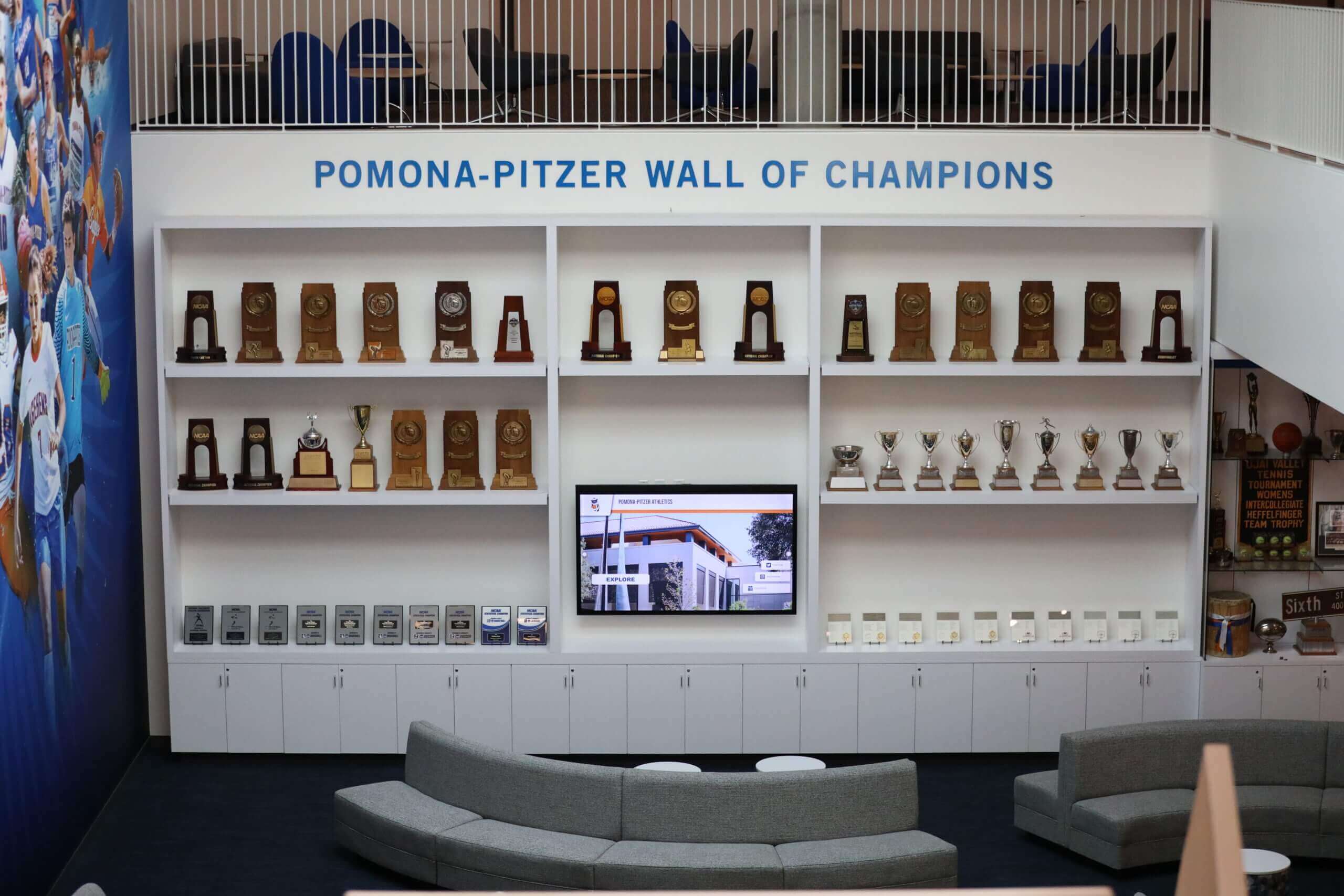Key Takeaways
Discover how interactive advancement solutions transform fundraising and donor engagement. Learn about touchscreen technology, digital recognition displays, and proven strategies for advancement offices.
According to recent research, gifts to American colleges and universities totaled $61.5 billion in fiscal year 2024, representing a 3% increase from the previous year. Yet donor retention rates remain challenging, with the average educational institution retaining only 43-45% of donors year-over-year according to the Fundraising Effectiveness Project. Interactive advancement solutions address this retention challenge by creating memorable donor experiences that strengthen relationships and encourage continued giving.
Understanding Interactive Advancement Solutions
An interactive advancement solution is a comprehensive technology platform that combines hardware, software, and content management capabilities to transform how educational institutions recognize donors, engage alumni, and support fundraising campaigns.
Core Components of Modern Advancement Solutions
Interactive Touchscreen Displays
Commercial-grade touchscreen kiosks ranging from 43 to 75 inches provide the physical interface where donors, alumni, and visitors engage with recognition content. These displays feature capacitive touchscreen technology that responds to familiar gestures like swiping, tapping, and pinching—the same interactions people use on smartphones and tablets.
Unlike consumer-grade displays, commercial touchscreens are engineered for continuous operation in high-traffic environments, typically rated for 16-24 hours of daily use over 5-7 year lifespans. This reliability is essential for advancement offices that need technology they can depend on without constant maintenance.
Cloud-Based Content Management
Modern interactive advancement solutions feature intuitive, cloud-based administrative interfaces that allow authorized staff to manage content from any internet-connected device. Advancement professionals can add new donors, update giving levels, modify campaign progress, and publish changes instantly without technical expertise or vendor coordination.
This accessibility transforms content management from a bottleneck requiring IT support into a streamlined process that advancement teams control directly. The ability to make real-time updates ensures recognition stays current and donors receive timely acknowledgment of their support.
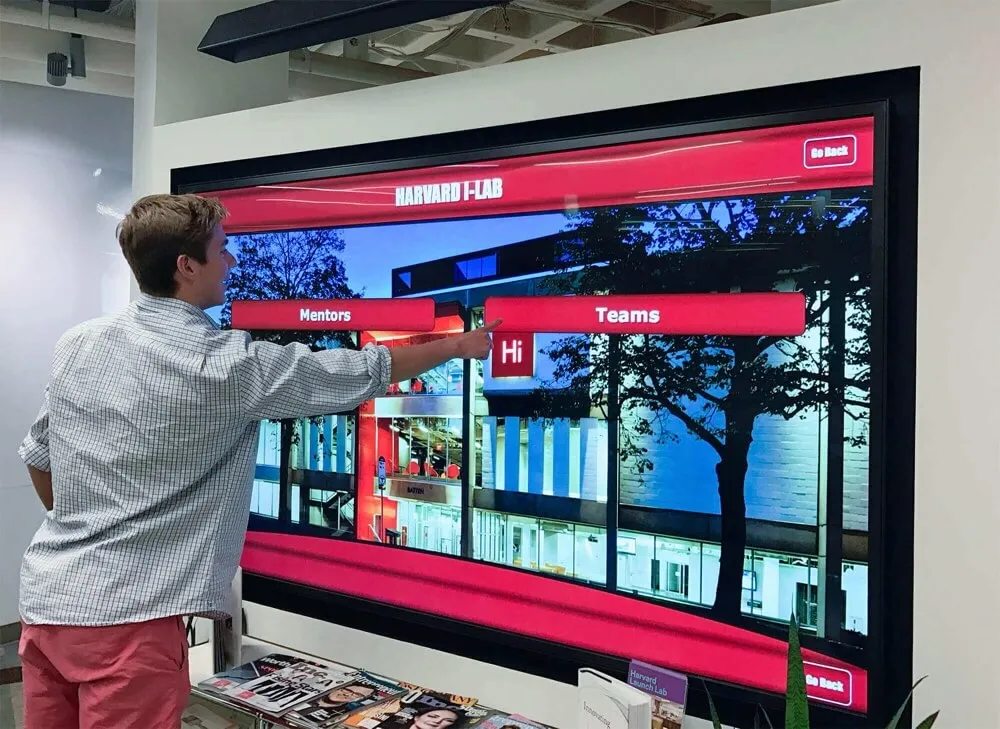
Rich Multimedia Content Capabilities
Interactive solutions enable advancement offices to move beyond simple name lists to create compelling donor stories that inspire giving. Content capabilities typically include:
- High-resolution photography from events, ceremonies, and campus locations
- Video testimonials from donors explaining their motivation
- Detailed biographical profiles highlighting donor connections to the institution
- Impact statements showing how specific gifts created change
- Historical timelines tracking giving societies and campaign progress
- Searchable databases allowing visitors to find specific donors or giving levels
This multimedia approach creates emotional connections with recognition content that static plaques cannot match. Schools implementing comprehensive digital donor recognition displays report significantly higher engagement rates compared to traditional recognition methods.
Analytics and Engagement Tracking
Perhaps the most transformative component is the data and insights that interactive solutions provide. Advanced analytics track:
- Total interactions and unique visitors over time
- Session duration revealing engagement depth
- Most viewed profiles and content
- Search queries showing visitor interests
- Peak usage times informing optimal update schedules
- Return visitor rates indicating sustained interest
These metrics enable data-driven optimization of recognition content and provide evidence-based justification for technology investments. Advancement teams can demonstrate measurable ROI through documented usage patterns and engagement trends.
Why Interactive Advancement Solutions Transform Fundraising
Traditional approaches to donor recognition and advancement technology create unnecessary limitations that constrain fundraising effectiveness. Interactive solutions eliminate these barriers while introducing powerful new capabilities.
Unlimited Recognition Capacity
Physical donor walls fill quickly, forcing advancement offices to establish giving thresholds that exclude smaller donors or require costly expansion projects. This limitation undermines inclusive recognition strategies that celebrate all supporters.
Interactive solutions provide virtually unlimited recognition capacity. Whether an institution has 100 donors or 10,000, the same touchscreen system accommodates growth without additional hardware costs. This scalability allows advancement offices to:
- Recognize donors at all giving levels appropriately
- Create multiple recognition tiers with appropriate visual hierarchy
- Add giving societies and clubs without space constraints
- Expand historical coverage as archival information becomes available
- Accommodate campaign-specific recognition alongside annual giving
The flexibility supports comprehensive recognition programs that align with advancement strategy rather than physical limitations.
Dynamic Content That Evolves Over Time
Static displays remain unchanged until physically modified, creating recognition that becomes stale and outdated. Interactive advancement solutions enable dynamic content that keeps donor recognition fresh and engaging:
Seasonal Content Rotation
- Featured donor spotlights changed monthly or quarterly
- Campaign progress updates showing real-time fundraising status
- Event promotion for giving days, galas, and reunions
- Anniversary recognition of significant giving milestones
- Thematic collections highlighting specific areas of support
Timely Donor Acknowledgment
New donors can appear in recognition displays within minutes of gift processing rather than waiting months for engraving and installation. This immediacy demonstrates organizational responsiveness and reinforces positive feelings associated with giving.
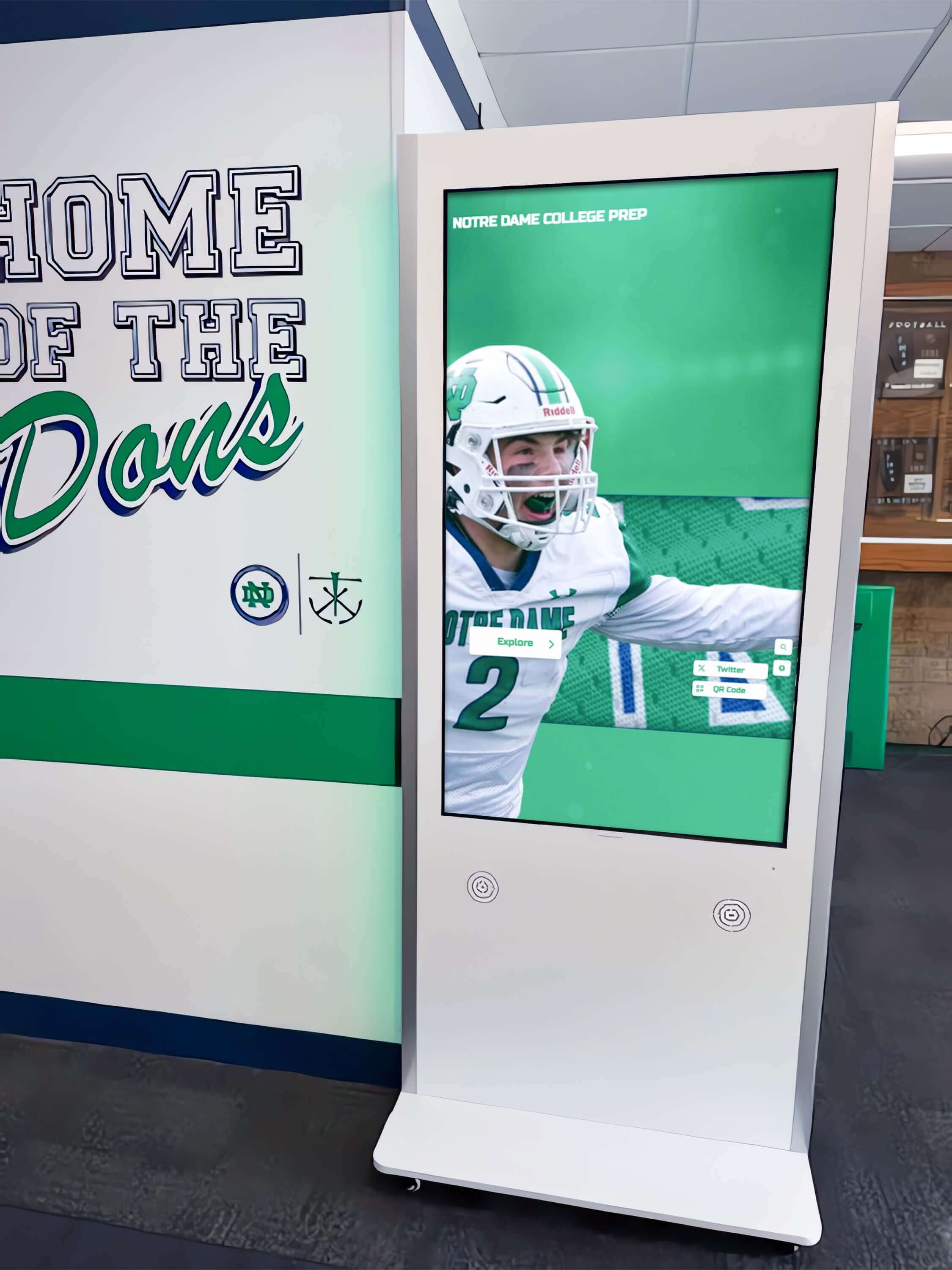
Campaign Visualization
During active campaigns, interactive displays serve as powerful visual tools showing:
- Thermometer-style progress bars updating daily
- Recognition of recent gifts appearing immediately
- Countdown timers creating urgency as deadlines approach
- Class leaderboards encouraging friendly competition
- Before-and-after project visualizations showing impact
This dynamic approach to campaign support maintains donor engagement throughout multi-year initiatives, not just at launch and conclusion. Institutions implementing fundraising strategies using digital recognition report accelerated gift commitments and increased campaign momentum.
Enhanced Donor Stewardship and Engagement
Research shows that 90% of donors prefer experiential recognition over physical formats like letters or gifts. Interactive advancement solutions create engaging experiences that strengthen donor relationships:
Interactive Discovery and Exploration
🔍 Personalized Navigation
Donors can search for their own profiles, explore giving society membership, and discover recognition content personally relevant to them
👥 Network Building
Browsing features enable donors to find fellow supporters, classmates, and colleagues who share their philanthropic commitment
📱 Social Sharing
Digital content is inherently shareable, allowing donors to post their recognition to social media and extend institutional visibility
🌍 Online Access
Companion websites extend recognition beyond campus, allowing donors worldwide to view their profiles from anywhere
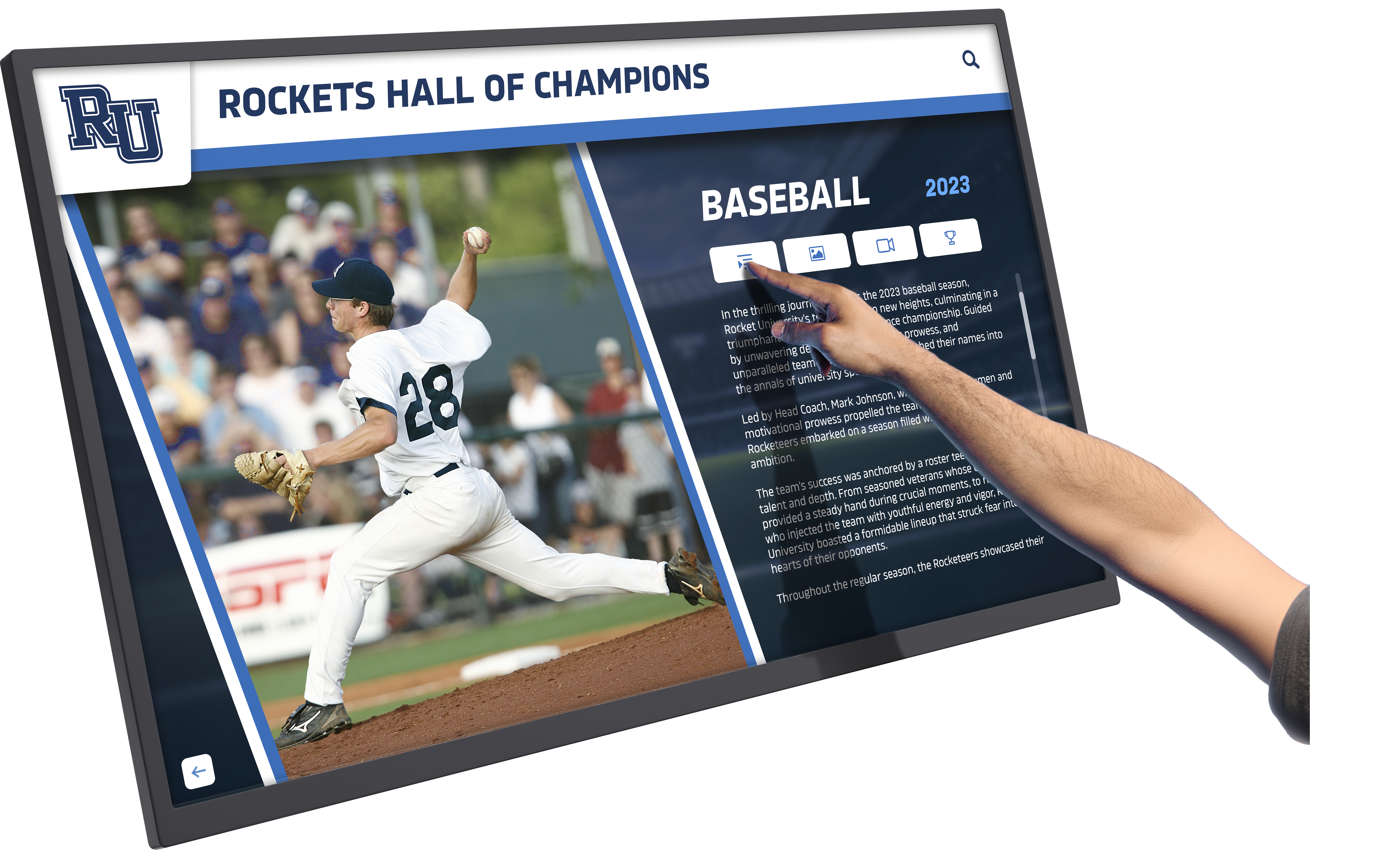
Stewardship Touchpoint Creation
Each interaction with recognition content represents a stewardship touchpoint—a moment when donors reengage with the institution and their giving decision. Unlike static plaques that provide a single moment of acknowledgment, interactive solutions create ongoing engagement opportunities.
Advancement offices can leverage these touchpoints by:
- Rotating featured donor spotlights monthly
- Adding thank you messages from institutional leadership
- Including student testimonials directed to specific donors
- Providing progress reports on projects funded by donations
- Celebrating anniversaries of significant gifts
This approach to donor stewardship scales efficiently, providing high-touch experiences without proportional staff time investments. The result is stronger donor relationships and improved retention rates.
Implementation: Building Your Interactive Advancement Solution
Successful interactive advancement solution implementation requires strategic planning and systematic execution. Understanding the key phases helps advancement offices navigate the process efficiently.
Phase 1: Strategic Planning and Stakeholder Alignment
Define Objectives and Success Metrics
Before selecting technology, advancement teams should clearly articulate what they hope to achieve:
- Increase donor retention rates by X%
- Recognize all donors above $Y threshold within Z days
- Boost campaign momentum through visible progress tracking
- Enhance alumni engagement at events and on campus visits
- Generate data insights to inform cultivation strategies
Specific, measurable objectives enable proper solution evaluation and post-implementation assessment of ROI.
Identify Key Stakeholders
Successful projects involve representatives from:
- Advancement Office (primary users and content managers)
- Executive Leadership (strategic vision and budget approval)
- IT Department (technical infrastructure and security)
- Marketing Team (brand consistency and messaging)
- Facilities Management (installation logistics and power)
Early stakeholder involvement prevents surprises and ensures requirements are captured comprehensively. For detailed guidance on stakeholder coordination, see this donor recognition touchscreen implementation guide.
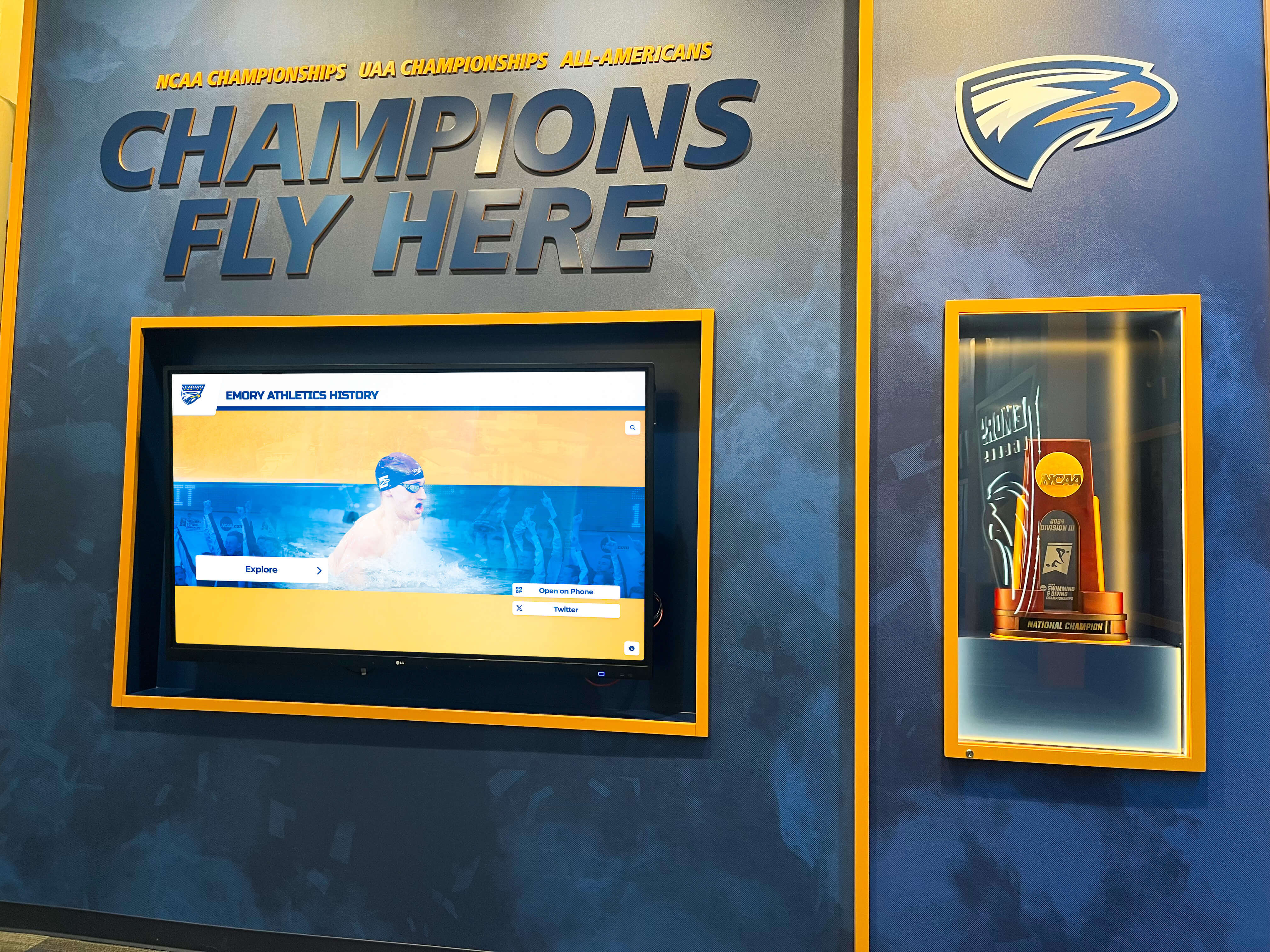
Location Selection and Traffic Analysis
Interactive displays deliver maximum impact in high-visibility, high-traffic locations where donors, alumni, and visitors naturally congregate:
- Main entrance lobbies and reception areas
- Alumni centers and advancement office common spaces
- Event venues used for galas, reunions, and ceremonies
- Athletic facilities hosting games and competitions
- Campus gathering spaces like student unions
Conducting simple traffic counts during typical weeks helps quantify potential impressions and justify investment. Prime locations typically see hundreds of daily passersby, translating to thousands of monthly engagement opportunities.
Phase 2: Solution Selection and Vendor Evaluation
Not all interactive advancement solutions deliver equal capabilities or advancement value. Thorough evaluation prevents costly mistakes and ensures long-term success.
Functional Requirements Checklist
- Intuitive content management requiring no technical expertise
- Flexible recognition structures supporting complex giving programs
- Robust search and filtering for donor discovery
- Analytics dashboard with engagement metrics
- Mobile and online accessibility extending reach beyond campus
- Integration capabilities with advancement databases
- Scheduled publishing for advance content preparation
- Multi-administrator access with role-based permissions
Vendor Evaluation Criteria
- Proven experience with educational institutions
- Strong client references from peer schools
- Comprehensive implementation support and training
- Responsive ongoing technical support
- Regular software updates and improvements
- Financial stability ensuring long-term viability
- Clear pricing with no hidden costs
- Commercial-grade hardware warranties
Total Cost of Ownership Analysis
Compare long-term costs of traditional recognition versus interactive solutions:
Traditional donor wall ongoing costs typically include:
- $200-$500 per donor plaque indefinitely
- Installation fees each time additions are made
- Periodic redesign as aesthetics become dated
- Space expansion costs when displays fill
- Maintenance and replacement of deteriorating elements
Interactive solution cost structure includes:
- One-time hardware and software investment ($15,000-$50,000 depending on size)
- Annual support and update fees ($1,000-$3,000 typically)
- Staff time for content updates (already budgeted)
- No per-recognition costs as programs scale
- Predictable maintenance with included support
For institutions recognizing 30+ donors annually, digital solutions typically achieve cost breakeven within 3-5 years while delivering superior engagement and operational benefits throughout.
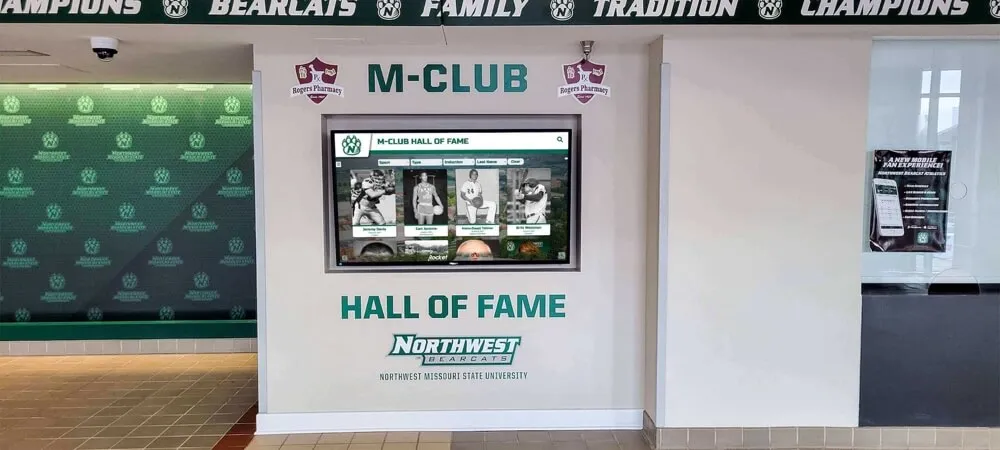
Phase 3: Content Development and Launch Preparation
Content development typically represents the most time-intensive phase, often requiring 8-12 weeks depending on the number of donors to be recognized and available historical information.
Content Gathering Strategy
Advancement offices should develop systematic approaches to collecting donor information:
Phased Content Approach
- Launch with recent, well-documented donors from past 5-10 years
- Expand historical coverage in phases as archival research allows
- Accept that comprehensive coverage is ongoing journey, not prerequisite
Multiple Input Sources
- Extract structured data from advancement database (names, giving levels, years)
- Mine alumni publications and event programs for biographical details
- Engage volunteers to submit stories and photographs
- Request input from donors themselves during cultivation conversations
- Digitize historical records and printed materials
Content Quality Standards
Maintain consistent quality across all profiles:
- Professional photography or high-resolution images (minimum 1920x1080 pixels)
- Well-written, edited biographical content (200-500 words per profile)
- Fact-checking and verification processes for accuracy
- Consistent formatting following established templates
- Regular review ensuring current, appropriate content
Systems like Rocket Alumni Solutions provide content management for digital recognition displays that streamline creation, approval workflows, and publishing.
Phase 4: Installation, Training, and Launch
Technical Installation
Professional installation ensures reliable, secure deployment:
- Mounting hardware anchored to structural elements
- Power and network connectivity properly configured
- Cable management for clean, professional appearance
- Security measures protecting equipment
- Accessibility compliance for all users
Most installations complete within 1-2 days depending on complexity and site preparation requirements.
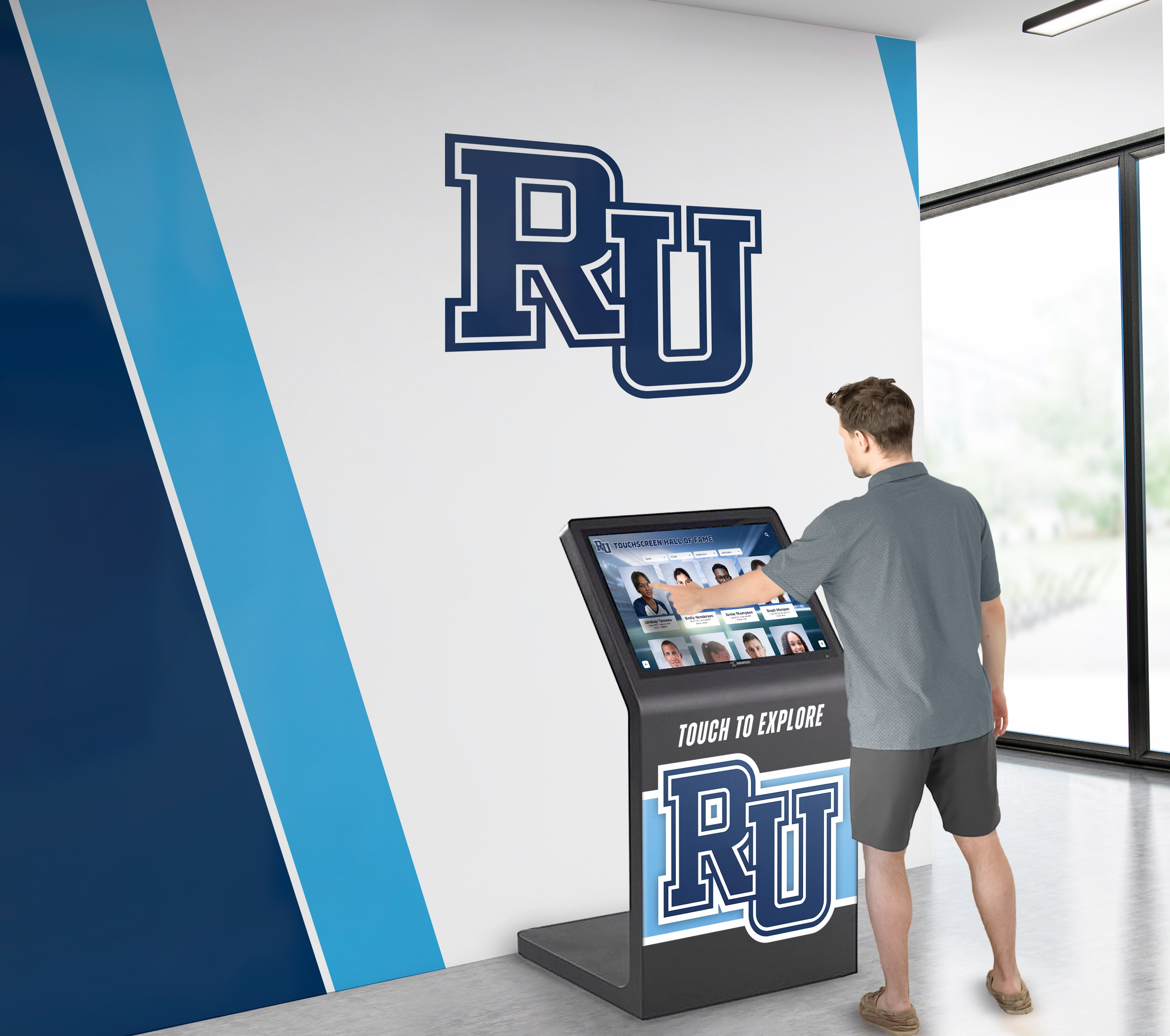
Staff Training and Adoption
Comprehensive training ensures advancement teams can maximize system capabilities:
- Hands-on workshops for primary content managers
- Video tutorials for reference and refresher training
- Written documentation and quick-start guides
- Office hours with vendor support during initial months
- Super-user designation for internal expertise development
Training investment during implementation pays dividends through confident, capable staff who leverage full system capabilities rather than using only basic features.
Launch Strategy
Strategic launches maximize visibility and engagement:
- Coordinate timing with major events or campaign milestones
- Develop promotional materials explaining features and benefits
- Invite donors to discover their profiles
- Generate media coverage for institutional visibility
- Celebrate implementation success with stakeholders
Best Practices for Maximizing Advancement Results
Implementation is just the beginning. Advancement offices that extract maximum value from interactive solutions follow proven best practices.
Strategic Content Planning and Regular Updates
Dynamic content keeps recognition engaging and demonstrates institutional vitality:
Recommended Update Cadence
- Major content additions quarterly (new donor groups, campaign updates, expanded profiles)
- Minor updates monthly (featured content rotation, event promotion)
- Weekly social media content derived from recognition system
- Daily monitoring of system performance and analytics
- Annual comprehensive review and refresh
Content Themes and Collections
Organize content strategically to highlight different aspects of giving:
- Giving society membership tiers
- Campaign-specific recognition
- Cumulative lifetime giving milestones
- Legacy society and planned giving commitments
- In-kind and volunteer contribution recognition
- Geographic collections (donors by region or city)
- Affinity group recognition (athletic supporters, scholarship donors)
Thematic organization helps visitors discover relevant content and enables targeted promotional campaigns around specific collections.
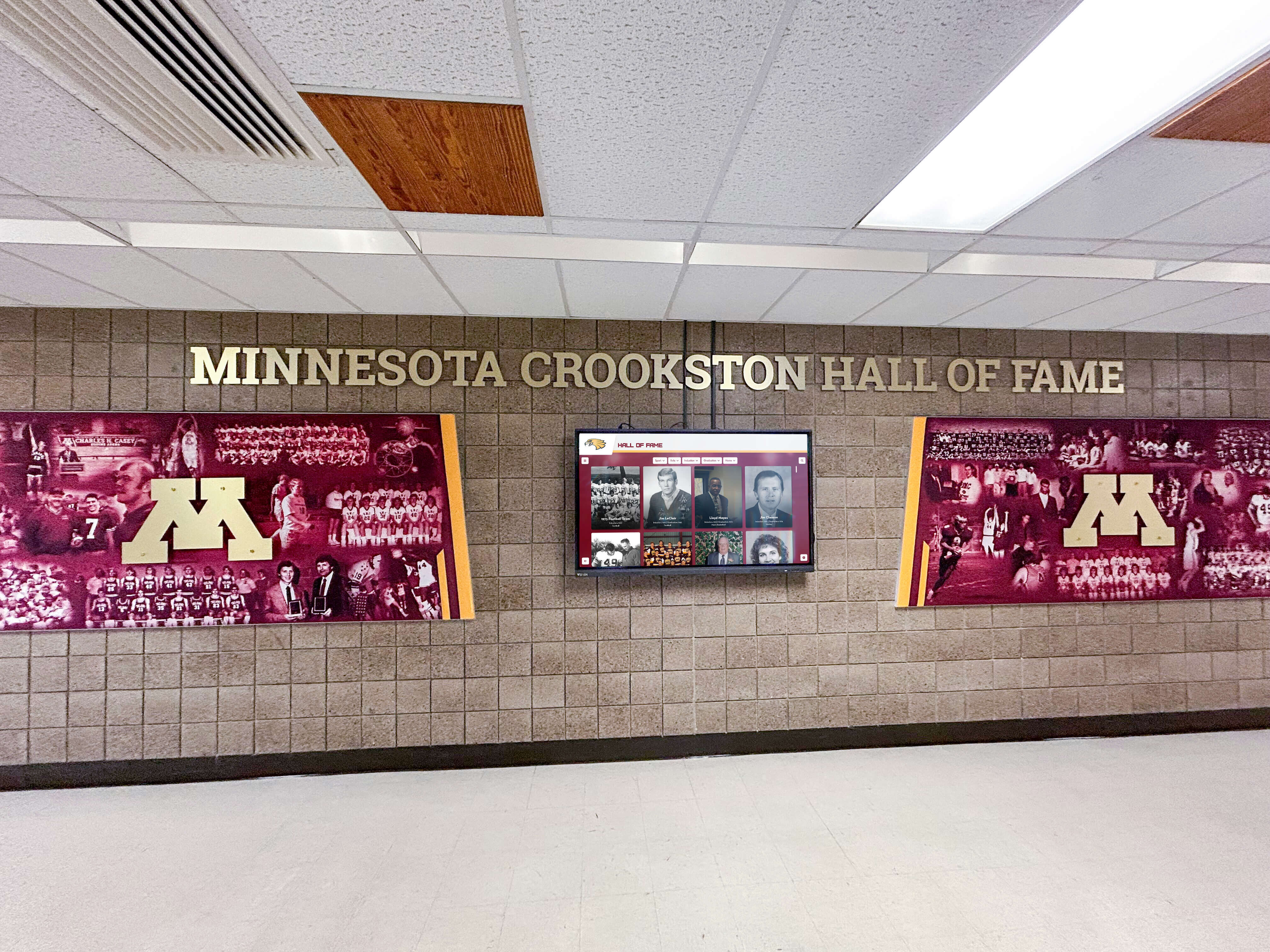
Data-Driven Optimization Using Analytics
Interactive advancement solutions generate valuable data that informs continuous improvement:
Monthly Analytics Review
Advancement teams should regularly examine:
- Total interactions and trend analysis
- Peak usage times informing update scheduling
- Most viewed profiles revealing donor interest
- Search queries showing what visitors seek
- Navigation patterns demonstrating exploration behavior
- Return visitor rates indicating sustained engagement
Performance-Based Content Decisions
- Expand high-performing content types that generate strong engagement
- Improve or remove low-engagement content that doesn’t resonate
- Feature content strategically based on viewing patterns
- Test different approaches to discover what works best
- Document lessons learned to inform future content development
Institutions focusing on measuring ROI from digital recognition use analytics to demonstrate technology value and justify continued investment.
Integration with Comprehensive Advancement Strategy
Interactive solutions deliver maximum value when integrated throughout advancement operations rather than existing as standalone technology:
Fundraising Integration Strategies
During Cultivation
- Show prospects how recognition will appear during facility tours
- Demonstrate peer giving through prominent displays
- Visualize naming opportunities at various giving levels
- Create customized preview content for major gift prospects
Campaign Communication
- Feature recognition prominently in campaign materials
- Include display photos in donor communications
- Coordinate content updates with campaign milestones
- Use analytics to identify highly engaged prospects
- Promote displays in fundraising presentations
Alumni Engagement Integration
Extend recognition beyond physical displays through:
- Website integration showing recognition content online
- Social media promotion highlighting featured donors
- Event programming incorporating recognition displays
- Alumni communications referencing recognition features
- Virtual tours for distant alumni unable to visit campus
For comprehensive approaches to engagement, explore strategies in this guide on alumni engagement through digital recognition.
Event Integration Opportunities
Position interactive displays strategically during:
- Giving days and annual fundraising campaigns
- Alumni reunions and homecoming weekends
- Gala fundraisers and recognition ceremonies
- Athletic events with large crowds
- New student and family orientation programs
- Board meetings and donor cultivation events
Each event creates opportunities to showcase recognition capabilities, drive engagement with content, and reinforce the value of philanthropic support.
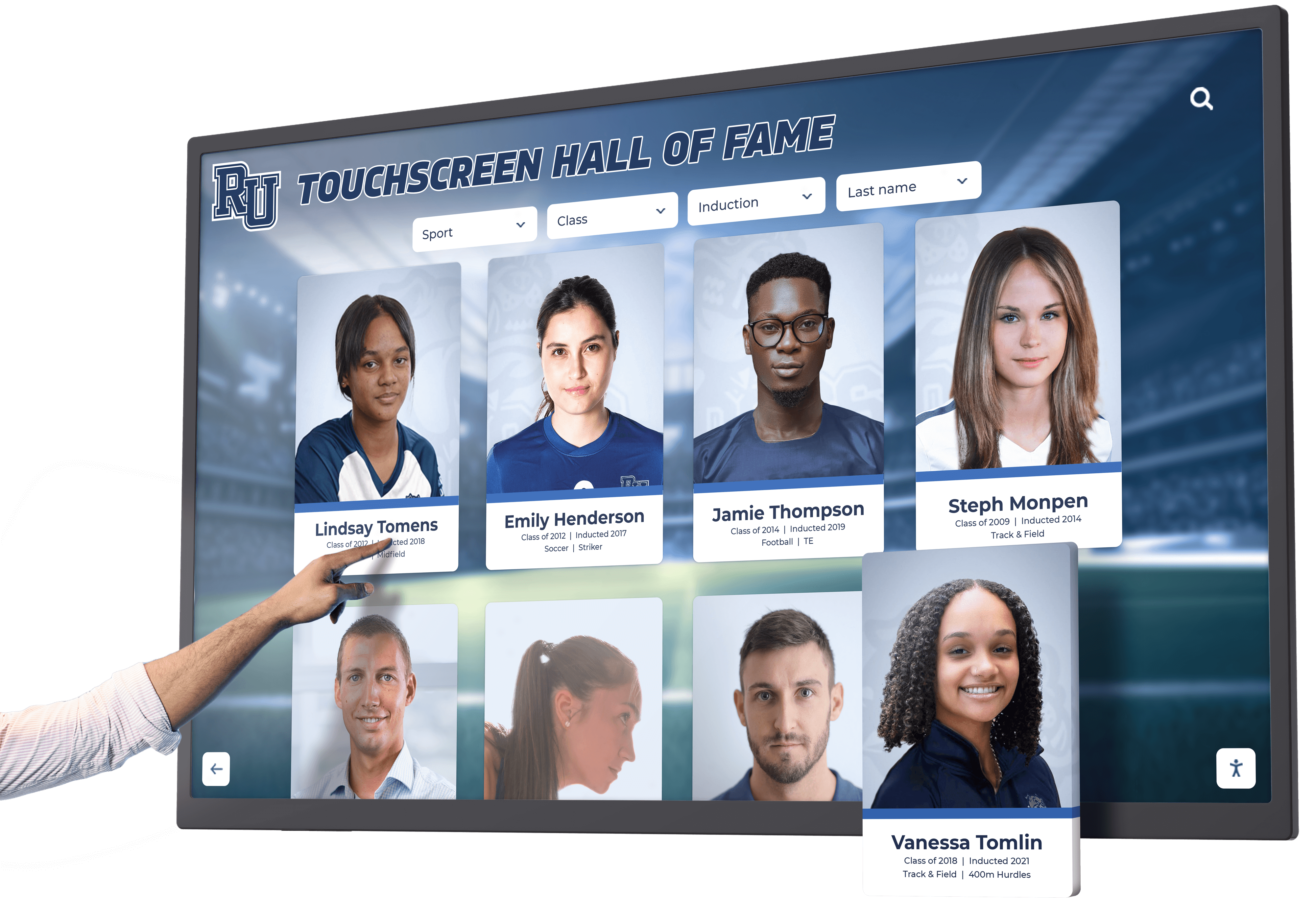
Overcoming Common Implementation Challenges
Even well-planned interactive advancement solution projects encounter obstacles. Anticipating common challenges enables proactive mitigation:
Challenge: Content Gathering Takes Longer Than Expected
Solution: Start with smaller initial sets focusing on recent, well-documented donors. Launch with strong foundation and expand coverage in phases. Engage volunteers and donors themselves to submit information. Accept that comprehensive coverage develops over time.
Challenge: Budget Approval Difficulties
Solution: Present phased implementation starting with single display. Calculate long-term ROI and savings versus traditional approaches. Identify fundraising opportunities specifically for recognition system. Document operational efficiency gains freeing staff time. Present comparison with peer institutions.
Challenge: Technical Integration Complexity
Solution: Prioritize solutions with proven integration capabilities. Begin with standalone implementation and add integrations in phases. Ensure IT involvement early in planning. Select vendors with strong technical support. Consider cloud-based solutions minimizing infrastructure requirements.
Challenge: Staff Resistance or Capacity Concerns
Solution: Involve staff in planning and vendor selection. Emphasize time savings over traditional recognition management. Provide comprehensive training with ongoing support. Start with less frequent updates and expand as comfort grows. Demonstrate quick wins building confidence and buy-in.
Challenge: Maintaining Momentum After Launch
Solution: Establish editorial calendar with planned updates. Assign clear ownership for content management. Set measurable engagement goals creating accountability. Share success metrics with stakeholders regularly. Celebrate milestones and positive feedback reinforcing value.
The Future of Interactive Advancement Solutions
Technology continues evolving, bringing new capabilities that will further enhance advancement effectiveness. Forward-thinking teams position themselves to leverage emerging trends:
Artificial Intelligence and Personalization
AI integration will enable:
- Automated content creation from structured database information
- Personalized recommendations based on visitor behavior patterns
- Natural language search understanding contextual queries
- Predictive analytics identifying high-probability donors based on engagement
- Voice interaction enabling hands-free exploration for accessibility
Enhanced Analytics and Attribution
Advanced analytics capabilities emerging include:
- Heat mapping showing exactly where users interact on screens
- Dwell time analysis identifying most compelling content elements
- Conversion tracking from interaction to donation
- Multi-touch attribution revealing how recognition influences giving
- Cohort analysis comparing different visitor segments
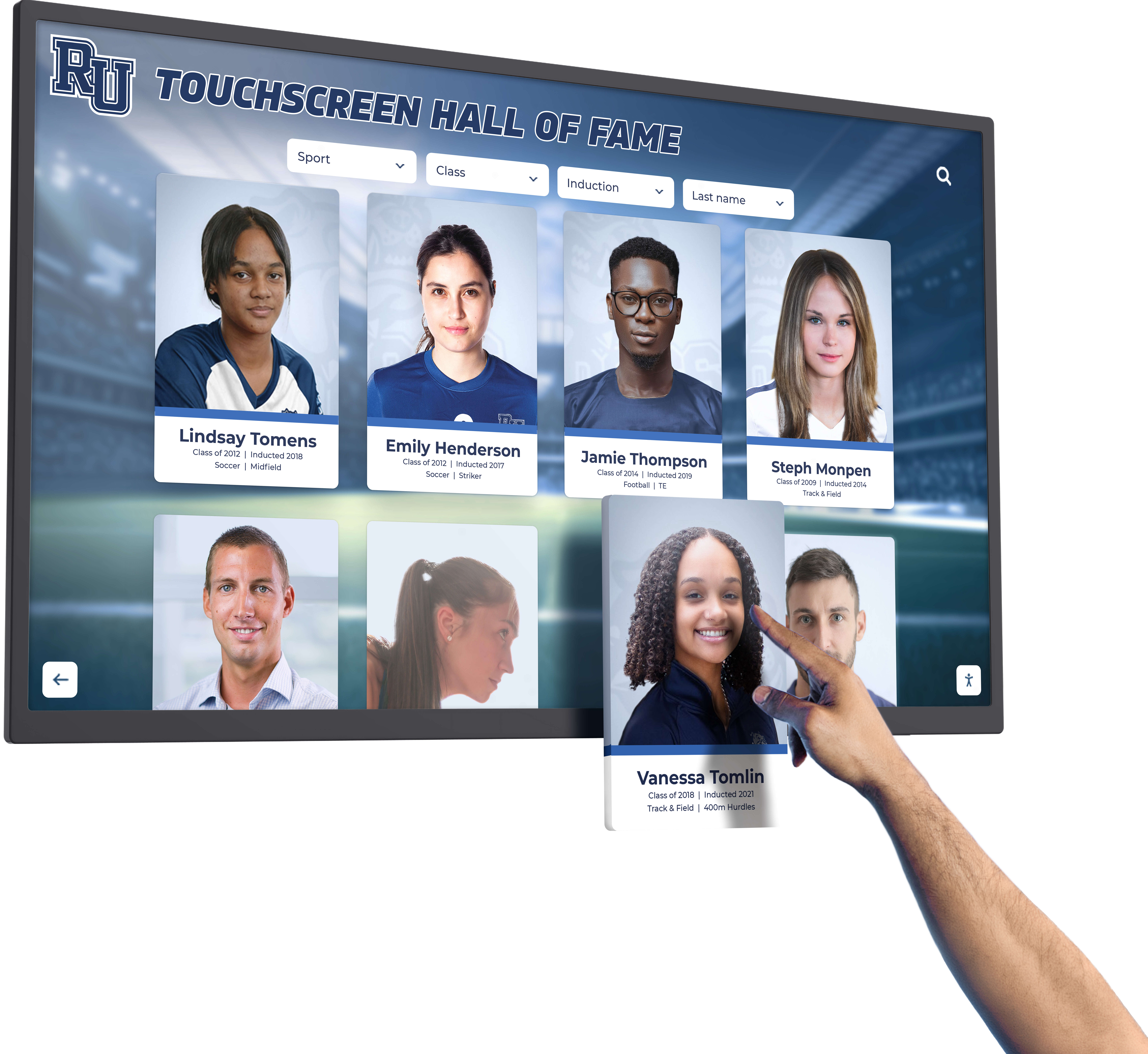
Augmented and Virtual Reality Integration
Extended reality technologies will provide:
- AR overlays adding additional context and information layers
- VR versions allowing remote immersive experiences for distant alumni
- 3D visualization of recognition and campus spaces
- Virtual facility tours combining wayfinding with donor recognition
- Holographic displays creating dramatic visual impact
Mobile-First and Omnichannel Experiences
Future solutions will seamlessly integrate:
- Mobile apps providing personal recognition dashboards
- Push notifications about featured content and campaign progress
- Social media integration for automatic sharing
- Email campaigns driving traffic to digital recognition
- Unified analytics across physical displays, websites, and mobile apps
For deeper exploration of advancement technology evolution, see trends covered in digital recognition displays for schools.
Measuring Success: Key Performance Indicators
Advancement offices should establish clear metrics demonstrating interactive solution value and informing continuous improvement:
Engagement Metrics
- Total interactions per month/year
- Unique visitors and return visitor rates
- Average session duration
- Content views and search queries
- Social sharing frequency
- Peak usage times and patterns
Fundraising Impact Metrics
- Donor retention rates year-over-year
- Average gift size trends
- Time from first gift to second gift
- Major gift pipeline velocity
- Campaign participation rates
- Giving society membership growth
Operational Efficiency Metrics
- Time required for donor recognition updates
- Cost per donor recognized
- Staff satisfaction with management tools
- System uptime and reliability
- Support ticket volume and resolution time
- Content production velocity
Strategic Value Indicators
- Stakeholder satisfaction surveys
- Donor feedback on recognition experiences
- Media mentions and publicity generated
- Alumni engagement at events
- Board member and volunteer enthusiasm
- Competitive positioning versus peer institutions
Regular reporting on these metrics demonstrates ongoing value, identifies optimization opportunities, and justifies continued investment in interactive advancement solutions.
Case Study Applications Across Institution Types
Interactive advancement solutions serve diverse educational institutions effectively, with implementation approaches adapted to specific contexts:
Large Research Universities
Major universities typically implement multiple displays across campus serving different constituencies:
- Medical school donor recognition in healthcare facilities
- Athletics recognition in sports venues and training centers
- School-specific displays in individual college buildings
- Centralized alumni recognition in main campus locations
- Library donor recognition in information commons
The scale enables sophisticated recognition programs with extensive donor populations and complex giving structures. Solutions like those offered by Rocket Alumni Solutions provide enterprise capabilities supporting multi-location deployments.
Small Private Colleges
Smaller institutions benefit from interactive solutions’ ability to maximize limited space:
- Single comprehensive display in central campus location
- Compact form factors suitable for smaller facilities
- Recognition of alumni achievements alongside donor support
- Integration of athletics, academics, and arts recognition
- Emphasis on personal stories and institutional intimacy
The scalability ensures small colleges access enterprise-grade capabilities at appropriate investment levels.
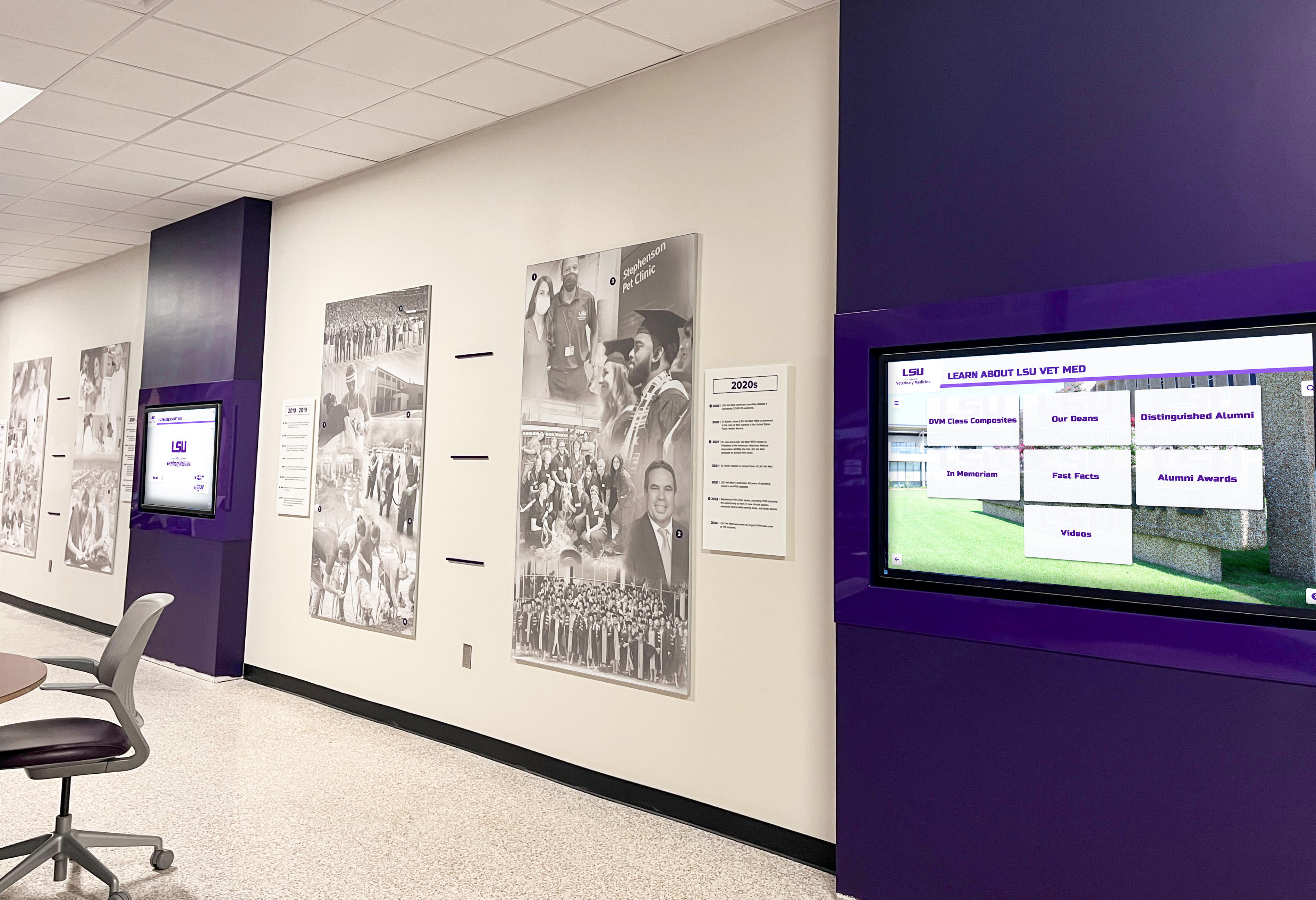
Independent Schools
K-12 independent schools leverage interactive advancement solutions for:
- Parent and grandparent giving recognition
- Endowed fund and scholarship donor acknowledgment
- Faculty and staff appreciation
- Student achievement celebration
- Historical timeline and institutional heritage
The flexibility supports unique recognition needs of independent school communities while providing advancement tools typically associated with higher education.
Community Colleges
Two-year institutions use interactive solutions to:
- Recognize foundation donors supporting scholarships
- Celebrate community partnerships and local sponsors
- Highlight successful alumni and transfer students
- Promote workforce development program supporters
- Showcase facility improvements funded by campaigns
For examples of community partnership recognition, see approaches outlined in showcasing community partnerships and local sponsors.
Procurement and Vendor Selection Guidance
Advancement offices navigating vendor selection benefit from structured evaluation processes:
Request for Proposal (RFP) Development
Comprehensive RFPs should specify:
Functional Requirements
- Content management system capabilities and ease of use
- Search, filtering, and navigation features
- Analytics and reporting functionality
- Integration requirements with existing systems
- Mobile and online accessibility needs
- Multi-administrator access and permissions
Technical Requirements
- Hardware specifications (screen size, resolution, durability ratings)
- Network and power requirements
- Security and data protection standards
- Accessibility compliance (ADA, WCAG)
- Warranty and support terms
- Software update and maintenance approach
Vendor Qualifications
- Years in business and financial stability
- Educational institution client references
- Implementation process and timeline
- Training and support offerings
- Pricing structure and payment terms
Vendor Demonstrations and Site Visits
Effective evaluation includes:
- Live demonstrations of content management systems
- Trial periods allowing staff to test usability
- Site visits to reference installations at peer institutions
- Conversations with current clients about satisfaction and support
- Technical deep-dives with IT staff assessing architecture
Reference Checking Best Practices
When contacting vendor references, ask:
- What was implementation experience like? Timeline? Challenges?
- How responsive is vendor support when issues arise?
- Has software improved over time through updates?
- Would you select this vendor again knowing what you know now?
- What advice would you give institutions considering this vendor?
- How has system impacted advancement operations and results?
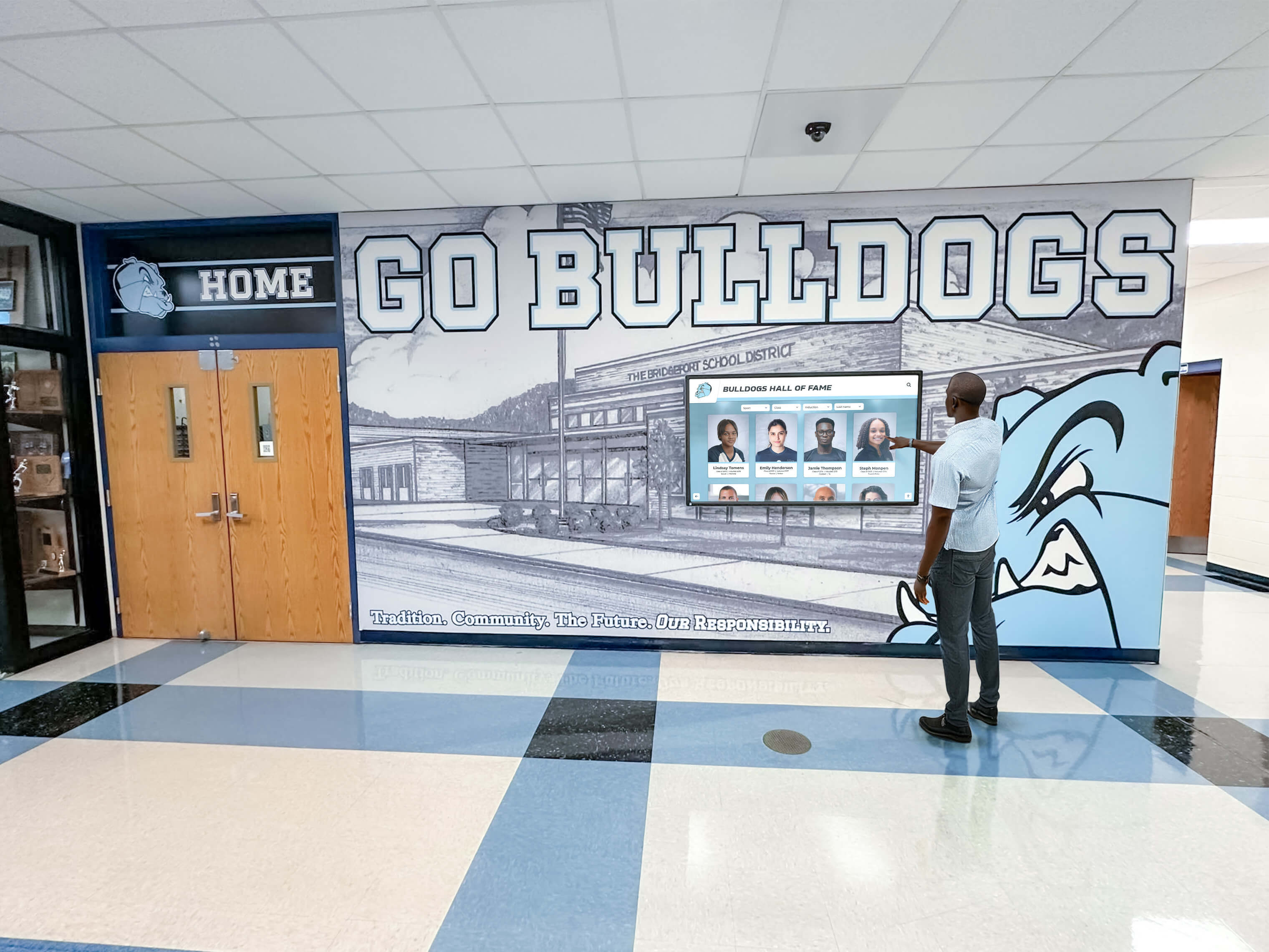
Conclusion: Transforming Advancement Through Interactive Solutions
Interactive advancement solutions represent far more than technology upgrades—they provide comprehensive platforms that transform how educational institutions recognize donors, engage alumni, support fundraising campaigns, and demonstrate stewardship excellence. By combining intuitive touchscreen interfaces, cloud-based management systems, rich multimedia content capabilities, and powerful analytics, these solutions address the fundamental challenges advancement offices face while creating new opportunities for constituent engagement.
The most successful implementations integrate interactive recognition throughout advancement strategy rather than treating displays as standalone technology. They establish regular content update cadences keeping recognition dynamic and relevant. They leverage analytics to continuously optimize content and approach. They train staff comprehensively to maximize system capabilities. And they position interactive solutions as foundations for broader digital transformation rather than endpoints.
As donor expectations continue evolving, competition for philanthropic support intensifies, and accountability for advancement results grows, institutions that embrace interactive advancement solutions position themselves for sustained fundraising success. The question is not whether interactive technology belongs in advancement operations, but how quickly organizations will implement solutions that deliver measurable impact supporting institutional mission and priorities.
For advancement professionals ready to transform donor recognition, alumni engagement, and fundraising effectiveness, interactive advancement solutions provide proven platforms that deliver results. The technology has matured, the business case is compelling, and peer institutions are demonstrating success—now is the time to act.
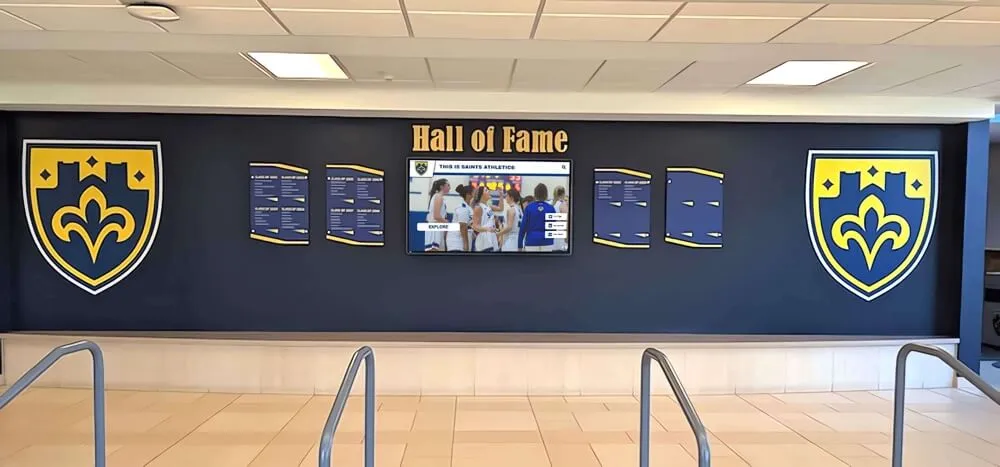
Ready to Transform Your Advancement Operations?
Interactive advancement solutions like those provided by Rocket Alumni Solutions offer comprehensive capabilities designed specifically for educational institutions. With intuitive content management, robust analytics, commercial-grade hardware, and dedicated support, these platforms help advancement professionals achieve their goals more efficiently and effectively.
Explore how digital trophy cases transform school recognition, learn about athletic history displays that celebrate institutional heritage, and discover alumni spotlight displays that strengthen connections with graduates. For technical guidance, review the touchscreen kiosk software guide and explore creating museum-style displays that showcase your institution’s story with professional impact.
Contact advancement technology providers today to discuss how interactive solutions can support your specific fundraising goals, donor recognition needs, and alumni engagement priorities. Whether you’re planning your first installation or expanding existing systems, proven expertise is available to guide successful implementation that delivers measurable advancement results.
